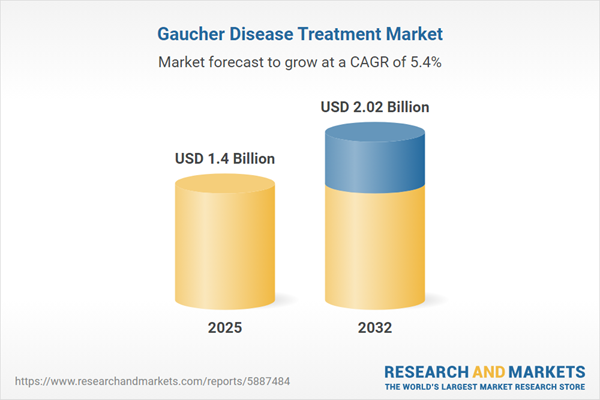Speak directly to the analyst to clarify any post sales queries you may have.
The Gaucher Disease Treatment Market is undergoing rapid transformation, driven by continual therapeutic innovation and adaptive regulatory policies. Senior decision-makers must adopt innovative, agile strategies to capitalize on emerging opportunities and address the intricacies of rare disease management.
Market Snapshot: Gaucher Disease Treatment Market Trends and Growth
Throughout the forecast period, the Gaucher Disease Treatment Market shows steady revenue expansion, with a notable CAGR underscoring market momentum. Growth is propelled by the integration of next-generation therapeutics, advancements in precision medicine, and ongoing improvements in pharmaceutical manufacturing. Modernizing the supply chain and adopting efficient regulatory pathways are driving competitive differentiation. As value-based care initiatives become more prominent, companies are reevaluating operational models to quickly adapt to evolving rare disease management trends. In response to shifting global health challenges, senior leaders are directing investment toward innovative drug development and patient-centric outreach, ensuring responsiveness within a dynamic business environment shaped by scientific and regulatory progress.
Scope & Segmentation
This report presents a comprehensive analysis aimed at guiding investment and strategic decisions for stakeholders active in Gaucher disease therapeutics. The evaluation covers pivotal dimensions critical for sustainable market success:
- Treatment Types: Chaperone therapies, enzyme replacement therapies, and substrate reduction options are analyzed to offer flexible clinical management approaches.
- Disease Types: Chronic systemic, acute neuropathic, and mixed systemic-neurological forms are addressed, each requiring specific monitoring and management strategies.
- Administration Modes: Intravenous infusions and oral therapies are examined, highlighting logistical, patient preference, and accessibility considerations across different healthcare environments.
- End Users: Detailed review includes clinics, home care models (nursing and self-administration), public hospitals, and private hospitals, representing varying care delivery modes.
- Patient Groups: Contrasts between adult and pediatric patient needs are explored, detailing distinctions in dosing, coordination, and outcome priorities.
- Geographical Coverage: Thorough evaluation encompasses the Americas—including the United States, Canada, Mexico, Brazil, Argentina, Chile, Colombia, and Peru—Europe, Middle East, Africa, and Asia-Pacific (notably China, India, Japan, Australia, and emerging growth territories), highlighting region-specific drivers and opportunities.
- Key Innovators: Competitive landscape features Sanofi SA, Takeda Pharmaceutical Company Limited, Pfizer Inc., Actelion Pharmaceuticals Ltd., Amicus Therapeutics, Inc., and Protalix BioTherapeutics, Inc., including pipeline developments, alliances, and commercial activities.
Key Takeaways for Senior Decision-Makers
- Personalized therapeutic strategies are transforming traditional care protocols, enabling targeted solutions for diverse patient profiles with complex underlying conditions.
- Ongoing enhancements in chaperone, enzyme replacement, and substrate reduction therapies support individualized approaches, recognizing the significance of genetic variation and clinical presentation.
- Strategic alliances, encompassing contract manufacturing, diagnostic integration, and patient advocacy, are accelerating development timelines and supporting data-driven adoption globally.
- The migration toward home-based care and expanded oral therapy options is improving adherence and access, reinforcing flexibility within modern healthcare delivery systems.
- Next-generation innovations, notably gene therapy and subcutaneous drug delivery, are intensifying market competition with a focus on measurable clinical outcomes and alignment with value-based payment models.
- Digitally enabled health monitoring and precision analytics are becoming integral for optimizing dosing, expediting regulatory submissions, and maintaining consistent standards in international care networks.
Tariff Impact: US Policy Changes and Global Supply Chain Considerations
Recent US tariff developments are reshaping supply chains for enzyme replacement and small molecule therapies in the Gaucher Disease Treatment Market. Rising production and logistics costs, particularly those linked to cold chain requirements, are leading manufacturers to reassess local manufacturing opportunities and adjust supplier strategies. Refinement of tariff classifications and pursuit of exemptions remain priorities as companies seek cost-effective solutions. In response, health payers are refining reimbursement benchmarks and placing greater emphasis on clinical and economic value. Early regulatory engagement and digital tracking are emerging as best practices to maintain global patient access and minimize resource constraints.
Methodology & Data Sources
The report synthesizes extensive secondary research from clinical and regulatory sources with direct insights from interviews and targeted surveys of clinicians and industry leaders. Triangulating these data points ensures a robust and accurate portrayal of evolving trends in Gaucher disease therapeutics.
Why This Report Matters
- Delivers a data-driven framework for prioritizing product development, investments, and market entry across diverse geographies and patient segments.
- Helps organizations anticipate regulatory shifts and supply chain disruptions, aligning strategy with tariff and macroeconomic dynamics.
- Supports leadership in benchmarking best practices and refining innovation initiatives, sustaining a competitive position in rare disease therapy.
Conclusion
This analysis provides actionable insights for senior leaders, equipping organizations to lead, innovate, and maintain strategic agility as the Gaucher Disease Treatment Market advances.
Additional Product Information:
- Purchase of this report includes 1 year online access with quarterly updates.
- This report can be updated on request. Please contact our Customer Experience team using the Ask a Question widget on our website.
Table of Contents
3. Executive Summary
4. Market Overview
7. Cumulative Impact of Artificial Intelligence 2025
List of Figures
Samples

LOADING...
Companies Mentioned
The key companies profiled in this Gaucher Disease Treatment market report include:- Sanofi SA
- Takeda Pharmaceutical Company Limited
- Pfizer Inc.
- Actelion Pharmaceuticals Ltd.
- Amicus Therapeutics, Inc.
- Protalix BioTherapeutics, Inc.
Table Information
| Report Attribute | Details |
|---|---|
| No. of Pages | 184 |
| Published | October 2025 |
| Forecast Period | 2025 - 2032 |
| Estimated Market Value ( USD | $ 1.4 Billion |
| Forecasted Market Value ( USD | $ 2.02 Billion |
| Compound Annual Growth Rate | 5.4% |
| Regions Covered | Global |
| No. of Companies Mentioned | 7 |









